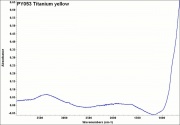Difference between revisions of "Titanium yellow"
Jump to navigation
Jump to search
m (Text replace - "\[http:\/\/cameo\.mfa\.org\/materials\/fullrecord\.asp\?name=([^\s]+)\s(.*)\]" to "$2") |
|||
| Line 8: | Line 8: | ||
Pigment Yellow 53; CI 77788; amarillo de titanio (Esp.); jaune de titane (Fr.); amarelo de titânio (Port.) | Pigment Yellow 53; CI 77788; amarillo de titanio (Esp.); jaune de titane (Fr.); amarelo de titânio (Port.) | ||
| + | == Physical and Chemical Properties == | ||
{| class="wikitable" | {| class="wikitable" | ||
|- | |- | ||
| Line 14: | Line 15: | ||
|} | |} | ||
| − | == | + | ==Resources and Citations== |
| − | + | * M.de Keijzer "A Brief Survey of the Synthetic Inorganic Artists' Pigments Discovered in the 20th Century" ICOM Preprints, Dresden 1990 p. 214-219. | |
[[Category:Materials database]] | [[Category:Materials database]] | ||
Latest revision as of 14:32, 10 June 2022
Description
A synthetic yellow pigment. Titanium yellow is a solid mixture of oxides of Nickel, Antimony, and Titanium. It was introduced in 1954 by the Harshaw Chemical Company in Cleveland (de Keijzer 1990).
Synonyms and Related Terms
Pigment Yellow 53; CI 77788; amarillo de titanio (Esp.); jaune de titane (Fr.); amarelo de titânio (Port.)
Physical and Chemical Properties
| Composition | NiO-Sb2O3-20TiO2 |
|---|
Resources and Citations
- M.de Keijzer "A Brief Survey of the Synthetic Inorganic Artists' Pigments Discovered in the 20th Century" ICOM Preprints, Dresden 1990 p. 214-219.
